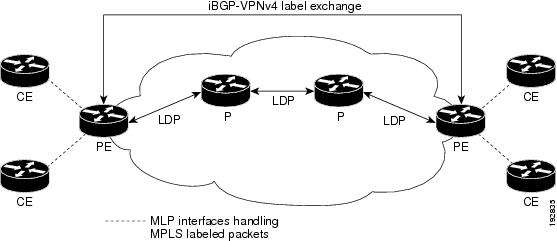bundle —A group of interfaces connected by parallel links between two systems that have agreed to use Multilink PPP (MLP) over those
links.
CBWFQ —class-based weighted fair queueing. A queueing option that extends the standard Weighted Fair Queueing (WFQ) functionality
to provide support for user-defined traffic classes.
Cisco Express Forwarding —A proprietary form of switching that optimizes network performance and scalability for networks with large and dynamic traffic
patterns, such as the Internet, and for networks characterized by intensive web-based applications or interactive sessions.
Although you can use Cisco Express Forwarding in any part of a network, it is designed for high-performance, highly resilient
Layer 3 IP backbone switching.
EIGRP —Enhanced Interior Gateway Routing Protocol. An advanced version of the Interior Gateway Routing Protocol (IGRP) developed
by Cisco. It provides superior convergence properties and operating efficiency, and combines the advantages of link-state
protocols with those of distance vector protocols.
IGP —Interior Gateway Protocol. An Internet protocol used to exchange routing information within an autonomous system. Examples
of common Internet IGPs include Interior Gateway Routing Protocol (IGRP), Open Shortest Path First (OSPF), and Routing Information
Protocol (RIP).
IGRP —Interior Gateway Routing Protocol. An Interior Gateway Protocol (IGP) developed by Cisco to address the issues associated
with routing in large, heterogeneous networks. Compare with Enhanced Interior Gateway Routing Protocol (EIGRP).
IS-IS —Intermediate System-to-Intermediate System. An Open Systems Interconnection (OSI) link-state hierarchical routing protocol,
based on DECnet Phase V routing, in which IS-IS devices exchange routing information based on a single metric to determine
network topology.
LCP —Link Control Protocol. A protocol that establishes, configures, and tests data link connections for use by PPP.
LFI —ink fragmentation and interleaving. The LFI feature reduces delay on slower-speed links by breaking up large datagrams and
interleaving low-delay traffic packets with the smaller packets resulting from the fragmented datagram. LFI allows reserve
queues to be set up so that Real-Time Protocol (RTP) streams can be mapped into a higher priority queue in the configured
weighted fair queue set.
link —One of the interfaces in a bundle.
LLQ —low latency queueing. A quality of service QoS queueing feature that provides a strict priority queue (PQ) for voice traffic
and weighted fair queues for other classes of traffic. It is also called priority queueing/class-based weighted fair queueing
(PQ/CBWFQ).
MLP —Multilink PPP. A method of splitting, recombining, and sequencing datagrams across multiple logical links. The use of MLP
increases throughput between two sites by grouping interfaces and then load balancing packets over the grouped interfaces
(called a bundle). Splitting packets at one end, sending them over the bundled interfaces, and recombining them at the other
end achieves load balancing.
MQC —Modular QoS CLI. MQC is a CLI structure that allows users to create traffic polices and attach these polices to interfaces.
MQC allows users to specify a traffic class independently of QoS policies.
NCP —Network Control Protocol. A series of protocols for establishing and configuring different network layer protocols (such
as for AppleTalk) over PPP.
OSPF —Open Shortest Path First. A link-state, hierarchical Interior Gateway Protocol (IGP) routing algorithm proposed as a successor
to Routing Information Protocol (RIP) in the Internet community. OSPF features include least-cost routing, multipath routing,
and load balancing. OSPF was derived from an early version of the IS-IS protocol.
PPP —Point-to-Point Protocol. A successor to the Serial Line Interface Protocol (SLIP) that provides device-to-device and host-to-network
connections over synchronous and asynchronous circuits. PPP works with several network layer protocols (such as IP, Internetwork
Packet Exchange [IPX], and AppleTalk Remote Access [ARA]). PPP also has built-in security mechanisms (such as Challenge Handshake
Authentication Protocol [CHAP] and Password Authentication Protocol [PAP]). PPP relies on two protocols: Link Control Protocol
(LCP) and Network Control Protocol (NCP).
RIP —Routing Information Protocol. A version of Interior Gateway Protocol (IGP) that is supplied with UNIX Berkeley Standard Distribution
(BSD) systems. Routing Information Protocol (RIP) is the most common IGP in the Internet. It uses hop count as a routing metric.
Virtual bundle interface —An interface that represents the master link of a bundle. It is not tied to any physical interface. Data going over the bundle
is transmitted and received through the master link.
WFQ —weighted fair queueing. A congestion management algorithm that identifies conversations (in the form of traffic streams),
separates packets that belong to each conversation, and ensures that capacity is shared fairly among the individual conversations.
WFQ is an automatic way of stabilizing network behavior during congestion and results in improved performance and reduced
retransmission.
WRED —weighted random early detection. A queueing method that ensures that high-precedence traffic has lower loss rates than other
traffic during times of congestion.





 Feedback
Feedback